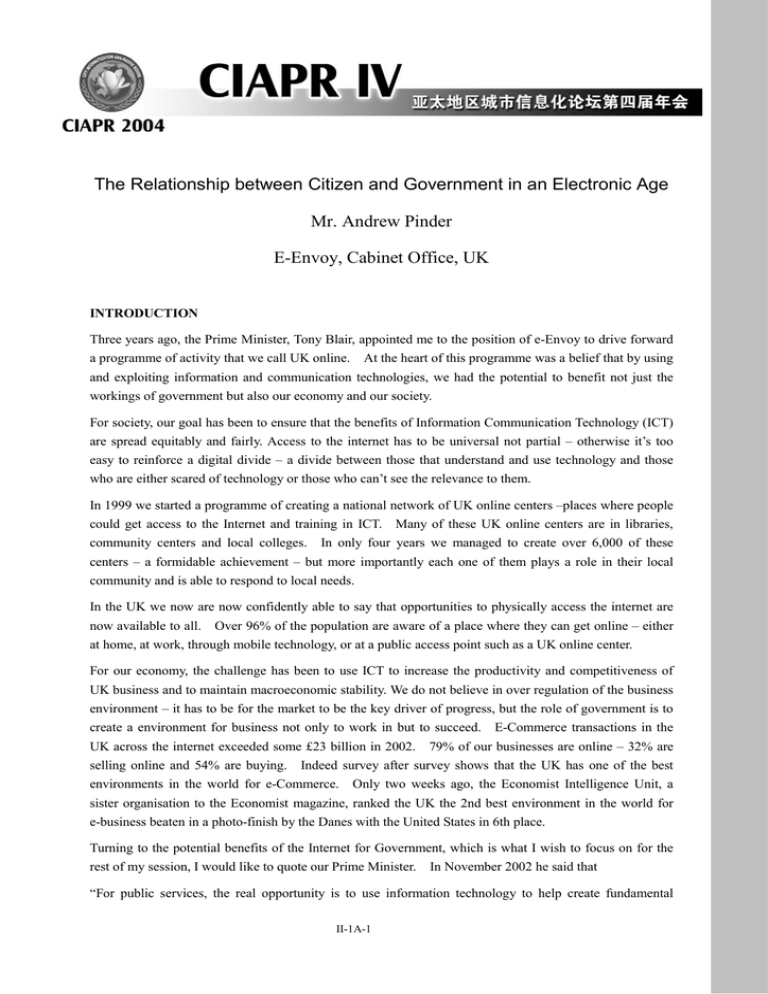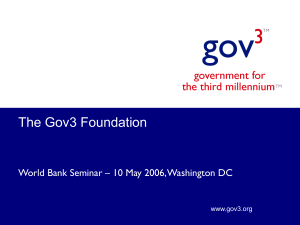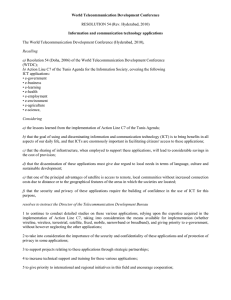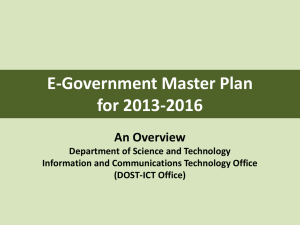The Relationship between Citizen and Government in an Electronic Age
advertisement

The Relationship between Citizen and Government in an Electronic Age Mr. Andrew Pinder E-Envoy, Cabinet Office, UK INTRODUCTION Three years ago, the Prime Minister, Tony Blair, appointed me to the position of e-Envoy to drive forward a programme of activity that we call UK online. At the heart of this programme was a belief that by using and exploiting information and communication technologies, we had the potential to benefit not just the workings of government but also our economy and our society. For society, our goal has been to ensure that the benefits of Information Communication Technology (ICT) are spread equitably and fairly. Access to the internet has to be universal not partial – otherwise it’s too easy to reinforce a digital divide – a divide between those that understand and use technology and those who are either scared of technology or those who can’t see the relevance to them. In 1999 we started a programme of creating a national network of UK online centers –places where people could get access to the Internet and training in ICT. Many of these UK online centers are in libraries, community centers and local colleges. In only four years we managed to create over 6,000 of these centers – a formidable achievement – but more importantly each one of them plays a role in their local community and is able to respond to local needs. In the UK we now are now confidently able to say that opportunities to physically access the internet are now available to all. Over 96% of the population are aware of a place where they can get online – either at home, at work, through mobile technology, or at a public access point such as a UK online center. For our economy, the challenge has been to use ICT to increase the productivity and competitiveness of UK business and to maintain macroeconomic stability. We do not believe in over regulation of the business environment – it has to be for the market to be the key driver of progress, but the role of government is to create a environment for business not only to work in but to succeed. E-Commerce transactions in the UK across the internet exceeded some £23 billion in 2002. 79% of our businesses are online – 32% are selling online and 54% are buying. Indeed survey after survey shows that the UK has one of the best environments in the world for e-Commerce. Only two weeks ago, the Economist Intelligence Unit, a sister organisation to the Economist magazine, ranked the UK the 2nd best environment in the world for e-business beaten in a photo-finish by the Danes with the United States in 6th place. Turning to the potential benefits of the Internet for Government, which is what I wish to focus on for the rest of my session, I would like to quote our Prime Minister. In November 2002 he said that “For public services, the real opportunity is to use information technology to help create fundamental II-1A-1 improvement in the efficiency, convenience and quality of our services…Our plan is not only to offer more convenient access to services but also to transform how we organize mainstream delivery. He went onto say that technology allows "a new relationship between citizen and state and the way we interact with each other". EGOVERNMENT TODAY Where are we today? Well in 1999, only a handful of central government services were available online. With that in mind, we set ourselves a target of ensuring that all government services were available online by 2005. Today, over two thirds of central government services have been e-enabled and every local authority has, at the very least, a website – although many of them are rolling out transactional services – sometimes on what seems to be a daily basis. An understanding of the potential of ICT is now deeply embedded across government and this has led to the provision of government information which, previously only accessible on paper, is now freely available online. An increasing number of transactional services are being made available electronically and are considered to be world leaders (such as NHS Direct, Worktrain etc). The Government Gateway, which we built in partnership with Microsoft, delivers world-leading integration and authentication. On the international stage, the UK’s performance towards the vision of an e-enabled government is comparable to that of overseas governments. However, there remains a key challenge for us – while we confident of meeting the target of all government services online by 2005 it has become apparent to us that we need to ensure that we prioritise those services in terms of those that will have the most impact for user benefits, government efficiency and alignment with overall policy priorities. In short, we need to ensure that the services are attractive and beneficial to users so that they achieve high levels of take-up – crucial if the potential benefits to both users and government are to be realized. It is of no benefit if we build these services and no-one uses them. That is why in September 2002, a new target for the delivery of e-services was set: 100% capability by 2005 with Key Services achieving high levels of use. This is an extremely challenging target and makes us think about how we build services around the needs of the citizen. There have been some encouraging signs. The Office of National Statistics in September of last year showed that 50% of the Internet population (29% of the adult population) had visited a government website in the last 12 months. Some services delivered by Government online have achieved particularly high levels of use. For example, university applications, vehicle registrations and company incorporations. Other services, such as self-assessment tax returns and money claims online, have shown strong growth over the past year. But, despite these successes, overall e-government transactions are still relatively low. II-1A-2 Only 8% of internet users claim to have transacted with a government department online. TAKE UP OF E-SERVICES Why is this so? What is the root cause of the take-up gap that exists in the UK between private and public sector online services? Customers in the UK are more than happy to shop or bank online but not seemingly to transact with Government. Extensive benchmarking and customer segment analysis has shown that the private sector and some overseas governments have delivered services in a much more customer focused way and that the poor design of UK e-government services has been a major barrier to take-up. What we currently have is government services currently fragmented across more than 3,000 gov.uk domain-name websites and 900 central government websites. The UK Online portal which my office launched in 2000 helped by providing a central 'signposting' service to navigate the maze of government web sites. In effect a Google for Government. However, this signposting service fell a long way short of providing a single entry point into government services and the joining up of services that was required. It became apparent to us that from the lack of impact on e-government service take-up that www.ukonline.gov.uk was not satisfying customer demands for a single entry point. To change the situation, and close the take-up gap, we needed to design more user-friendly services which are based firmly around customer needs. Up to now the focus has been on supply - the requirement to get all services online by 2005. This has created the situation where services have been rolled out aggressively but with government departments delivering services in a largely autonomous, 'inside-out', silo based way with limited consideration for customer needs and the clear opportunities afforded by customer overlap between departments’ services. There are a number of countries that have already undertaken a more customer friendly approach and as a consequence their citizens have embraced e-government. In particular, Canada, Australia and Sweden. Some common elements to their strategies which have contributed to success are: Focus on key transactional services; the portal has been based around high volume, high frequency services, Service clustering across organisational boundaries; Core audiences and topics used at all levels of navigation, around which government services are packaged to meet customer demand A single “all of government” site, distinctively branded and heavily promoted as the “main way-in” via multiple marketing and distribution channels A small number of “killer applications” driving take-up (e.g. Job Bank in Canada, driving lessons in California) II-1A-3 INTRODUCING DIRECTGOV Therefore, drawing on a best practice analysis of online banks, online shops and overseas governments we have launched Directgov, designed 'outside-in' around the customer. I believe that this service has the potential to dramatically transform Internet users’ relationships with government. We have taken government services and clustered them around audiences – for example, motorists, parents, the Disabled and topics e.g. transport and travel. With multiple government departments contributing relevant information and services to each of these clusters, the Directgov offering exploits customer overlap, by enabling common customers of different departments to access services from a single location that they might otherwise have been unaware of had they visited individual web sites. For example, a parent worried about bullying at school, or interested in learning more about the Child Tax Credit, can visit Directgov and find all the help and advice they need in the Parents section of the site. Similarly, a disabled person seeking information on home modification grants or advice on improving the usability of their computer need only visit Directgov to find everything they need in the sections designed for disabled people and carers. This joining-up of delivery across departments will, in the future, also enable value added functionality to be delivered - for example joint search facilities, common contact directories, single sign-on and single change of circumstances notification. Directgov stands to transform the current position of an individual citizen managing multiple relationships with different government departments - a situation that is inefficient from the perspective of all parties and move towards a single relationship between government and the individual. INTERMEDIARIES AND CHANNELS We recognise that we need to do more than just offer just a website. We also need to offer greater choice to citizens in the way they access our services - either through the use of intermediaries/third parties, or through different channels. It may be strange that as someone working in Government, but I amongst the first to recognize that acting alone, government will not necessarily have the best approach to e-service delivery. Therefore we need to create a marketplace where government and intermediaries from the public, private and voluntary sectors can come together to deliver e-government services that better meet the needs of our customers. Last May my office published a draft policy framework which outlined the principles of how intermediaries could become involved in the delivery of e-services and the support the Government needed to put in place to drive this forward. This idea has been well received and my office is engaged in driving forward the agenda, by providing practical support to potential intermediaries and public sector service providers in identifying opportunities for intermediation, and assessing and developing intermediary propositions. Alongside this, we need to ensure that we don’t see the Internet as the only answer to all of our e-services. II-1A-4 When we offer services, we need to ensure that citizens are able to access them in ways and places that are convenient to them. In the UK nearly half of all household have converted to digital TV and the use of mobile phones is almost universal – with over 70% of the population. Many parts of Government have responded well to this multichannel environment – for example some parents receive text messages if their children are late or don’t turn up for school. In London, motorists are able to pay the congestion charge by text. And in what we consider to be a world first, we have extended Directgov onto digital television. Although the presentation of the information is different, given the constraints of digital TV, we have taken the same principles of the Directgov website by providing government information structured around topics such as learning, health, local information and travel. There are clear benefits to using digital TV as an additional channel to the internet – not least being able able to reach millions more households who might not otherwise have been able to access Directgov if it were just on the Internet. We have also worked with a number of local authorities to put there information and services on the Directgov digital tv service and even though we’re only in phase one, and still very much learning, the types of services already available is impressive. By interacting with their television, citizens are now able to: Report Abandoned Vehicle Report streetlight failures Find out when their refuse is being collected Ask for repairs to their house And obtain a number of forms (such as housing benefit, council tax etc) Digital Television and Text messaging is only the start – with the advent of 3G and the rollout of wireless I’m confident that we will see more services being offered in a multichannel environment. LOOKING TO THE FUTURE As I have already mentioned, the environment from when I was appointed in 2000 to today is very different. The original task was to ‘get the UK online’. We now need to ensure that we continue to capitalize on the benefit of ICT to not only transforming service delivery but also achieving a step change in operational efficiency across the public sector. As many of you know, my position as e-Envoy comes to an end this year and this has given us the opportunity to refocus what my successor should concentrate on. If one recognizes that the Government is a complicated business which delivers a number of different services, then it should, like any other business, be using IT to transform that business and have a CIO with responsibility for helping to drive that change. This person, when appointed most probably later this summer, will take on the role as Head of eGovernment. Their specific responsibilities will include: Ensuring that we meet the 2005 target of all services online defining the architecture, requirements, and standards for common Government infrastructure and services; providing leadership and guidance for the Government IT community II-1A-5 In 1991 when Margaret Thatcher resigned as Prime Minister, she famously said of her relationship with her successful, John Major, that she wouldn’t “be pulling the levers” but she would “be a very good back-seat driver.”. I have no intention of doing that when I leave but I do leave in place some principles for the new Head of eGovernment which should underpin the delivery of public services. Those principles are Building services around customers. Use technology to fit government around customers, not customers into government. Moving towards web-based service delivery. The online channel should not be an add-on: all external services should be primarily web-based. Driving out cost from service delivery. The use of direct online access must be strongly encouraged. Many companies in the private sector have already realized the cost-savings that flow from active channel migration. Using technology to free up those in the front line of service delivery. Technology should be used to add value to services that are delivered face to face. Automating and integrating a greater number of back office functions. Public sector internal administration should be standardized and made self-service. CONCLUSION We cannot become complacent about what remains to be done. If successful The new style of service delivery will fundamentally change the way that citizens interact with Government. Getting the very best out of new technology means that we must continually innovate not just automate. Good, reliable trustworthy public services built around the needs of the citizen are essential to a modern, fair and dynamic society. I truly believe that we have laid the foundations on which to build and fundamentally enhance the relationship between the Government and citizens in the UK. Over the last three years I’ve been privileged to see this vision turn into a reality. that’s been done and excited about the future possibilities. II-1A-6 I’m immensely proud of the work






